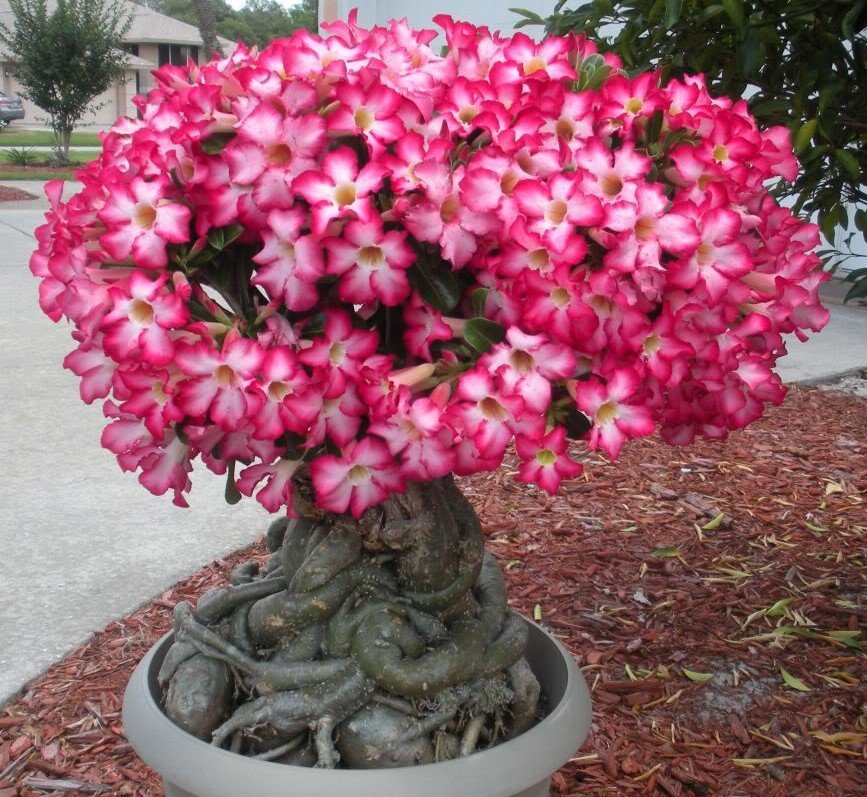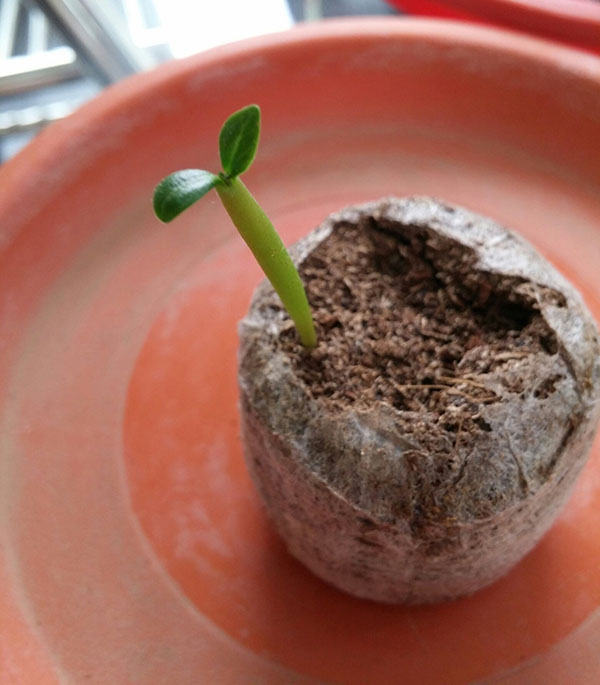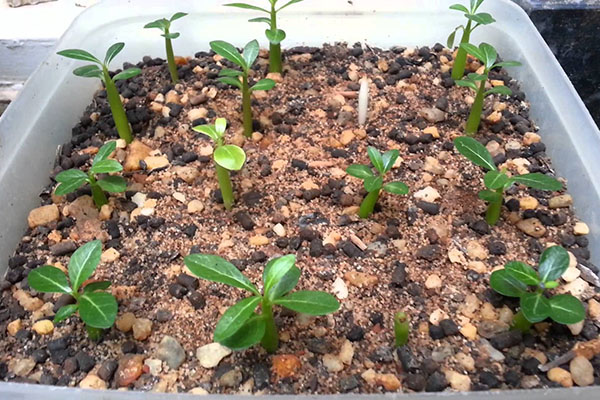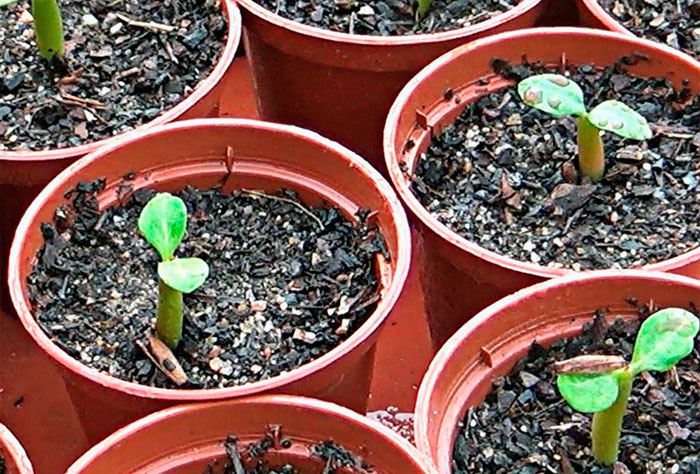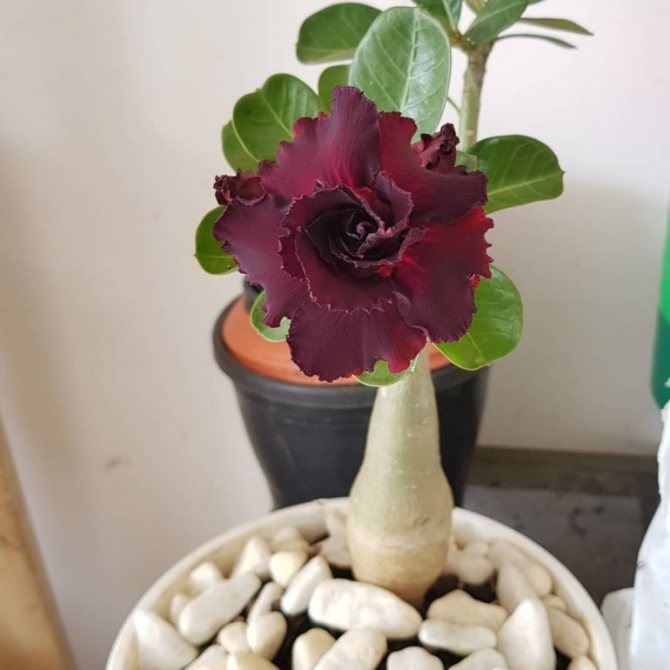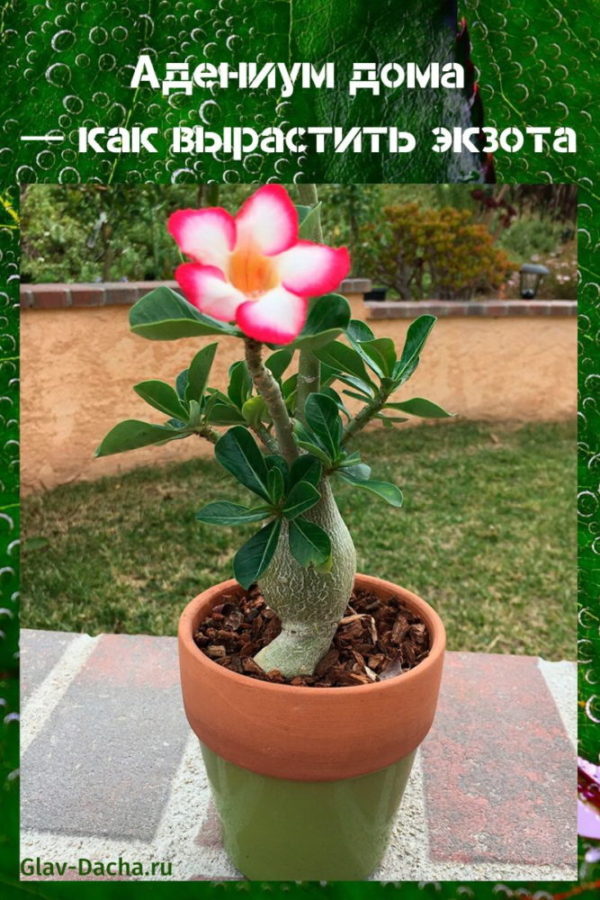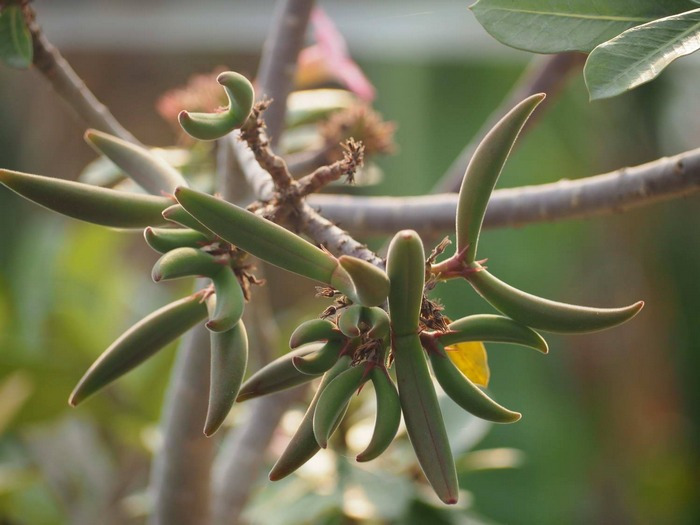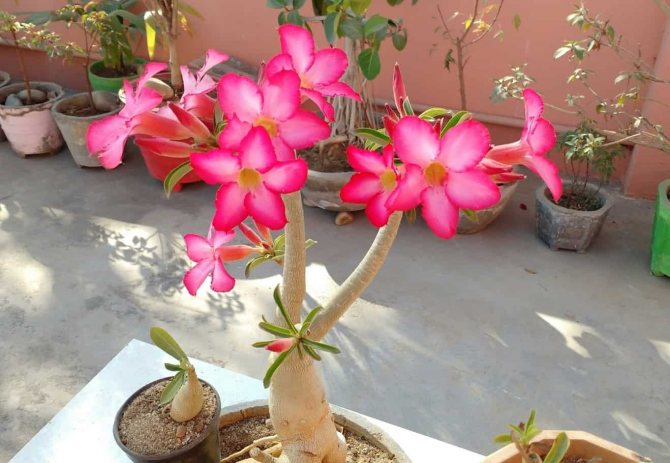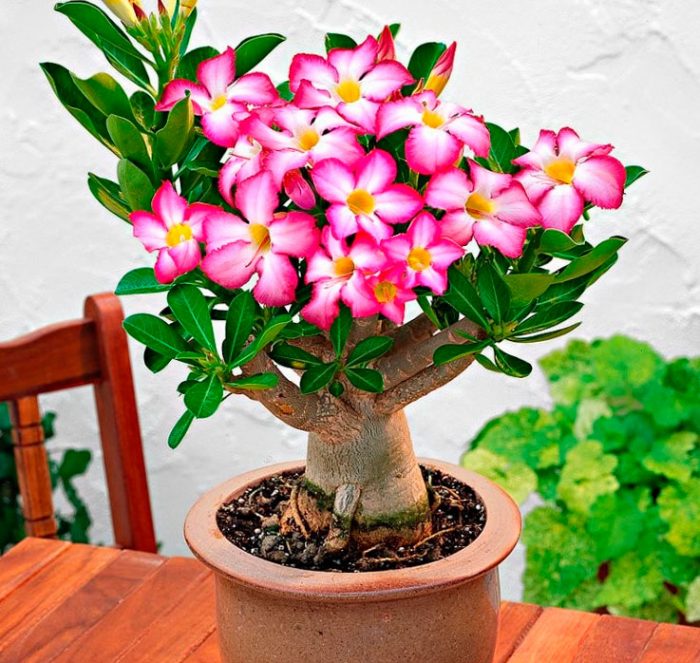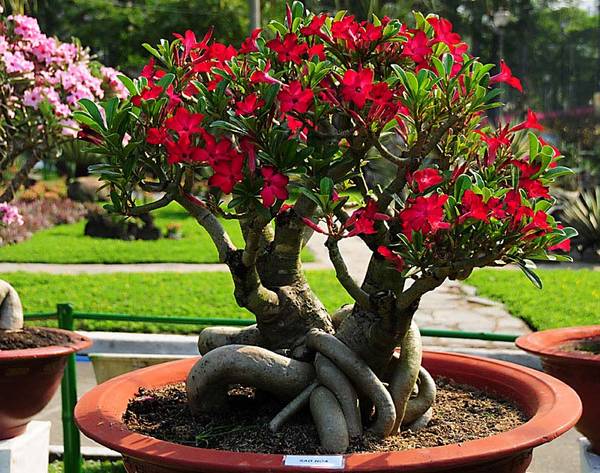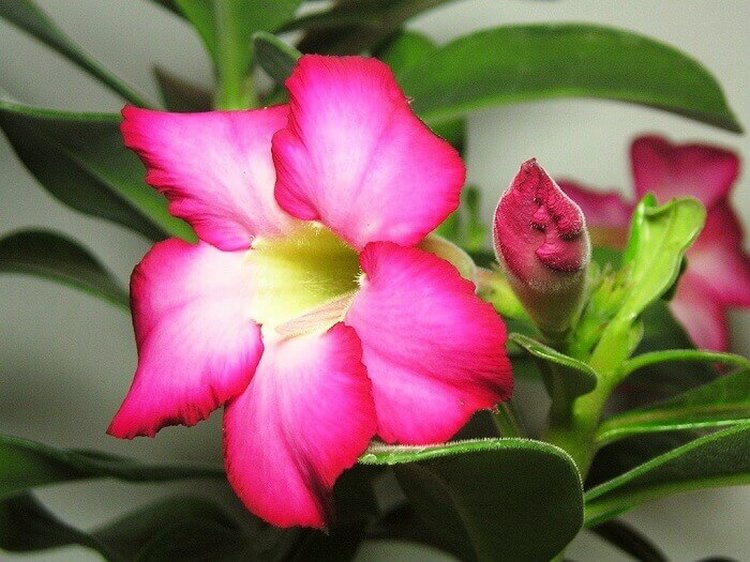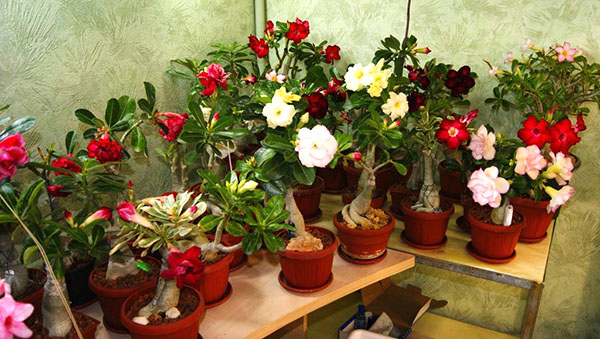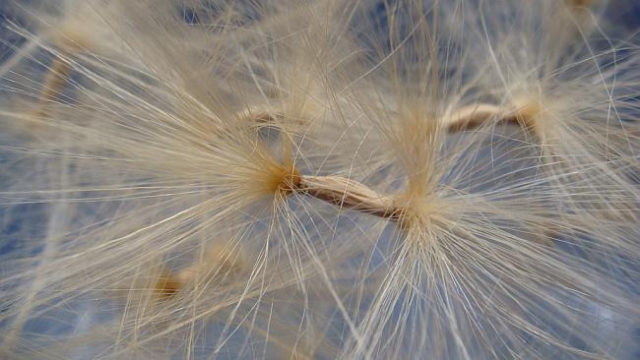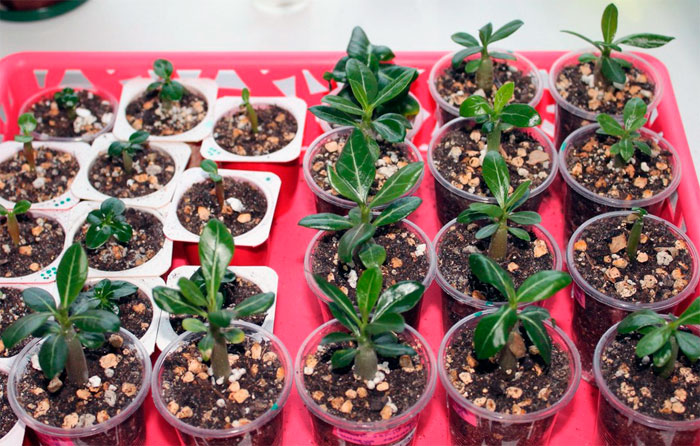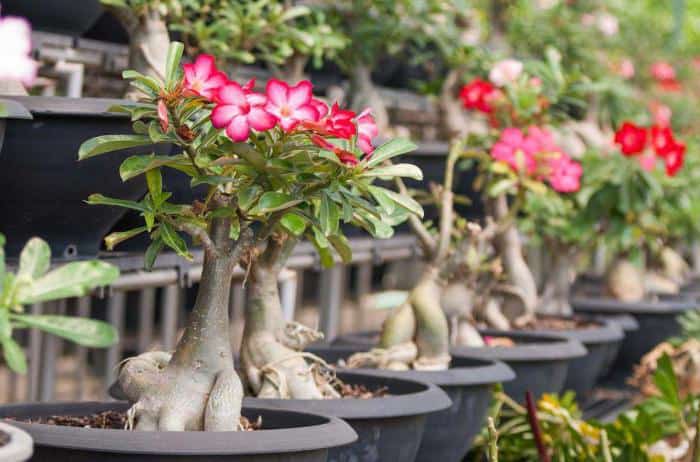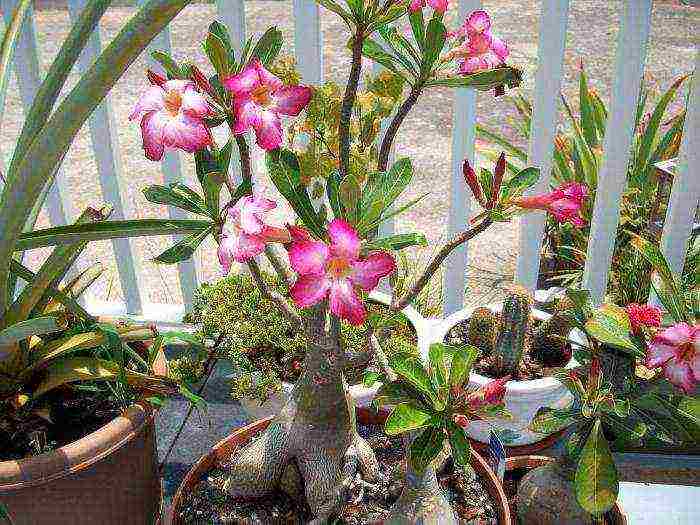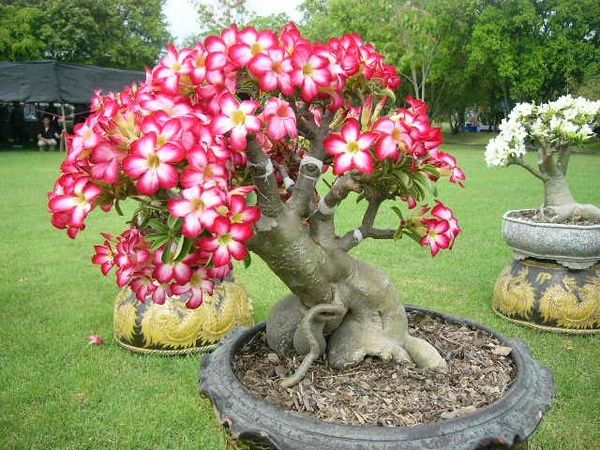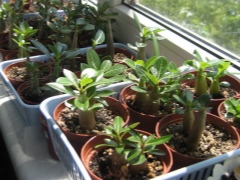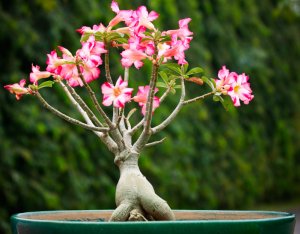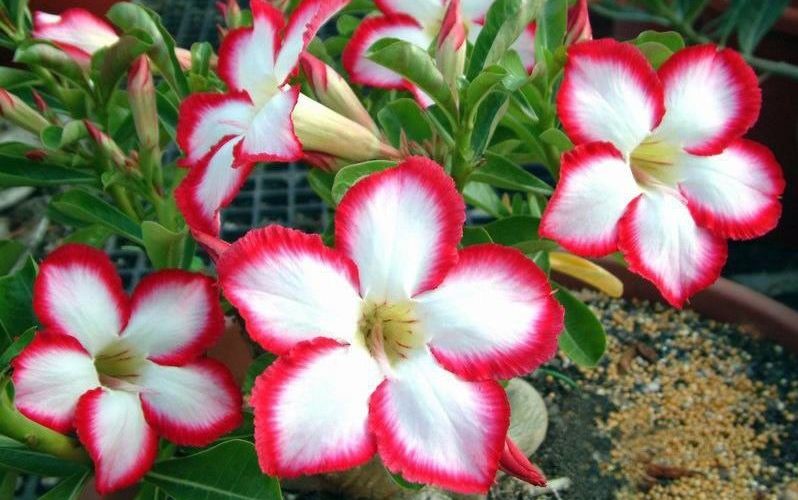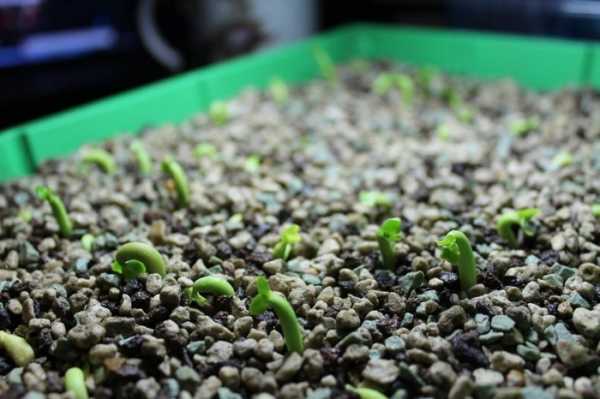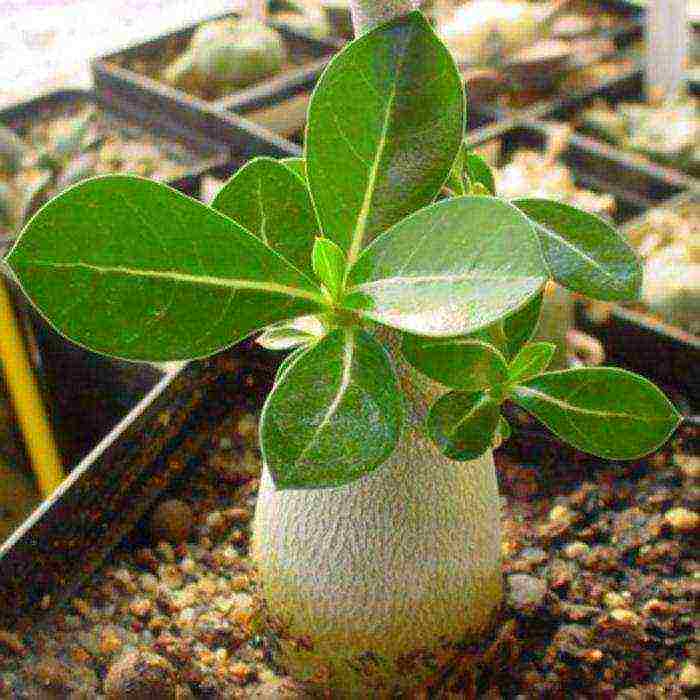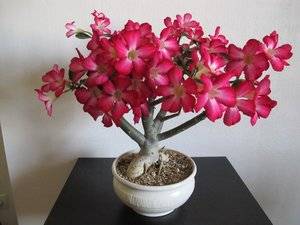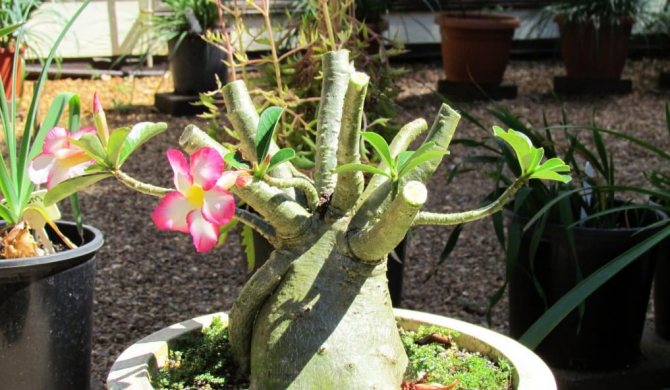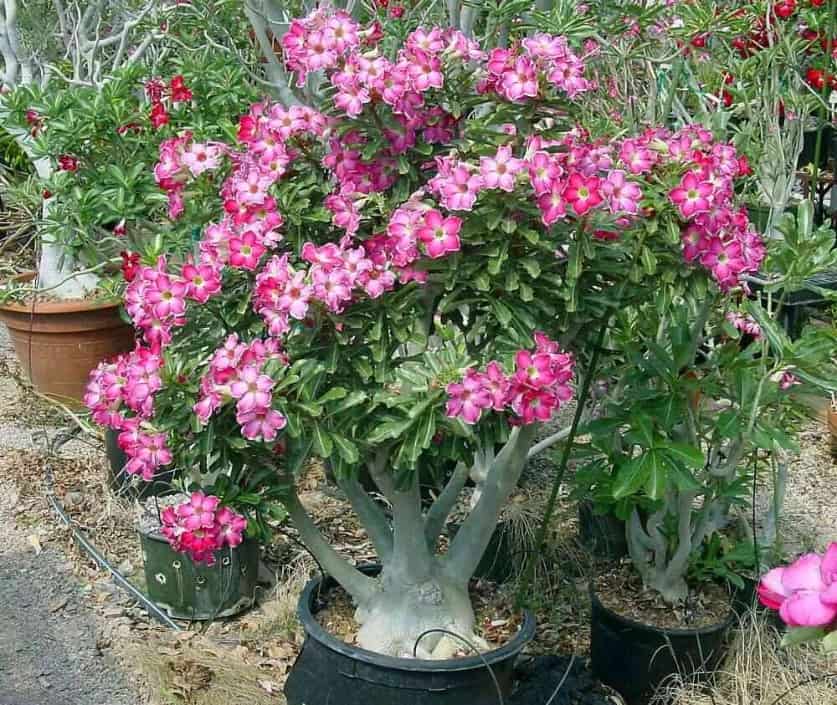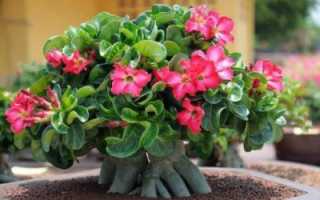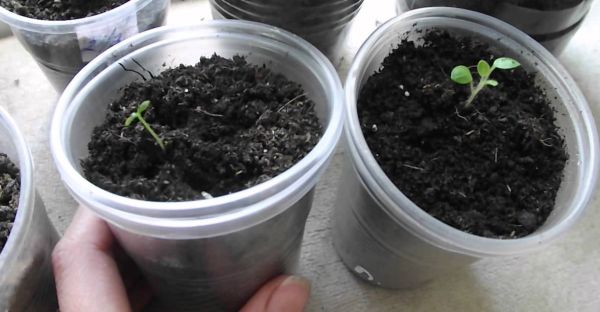Care
Despite the exotic origins of adeniums, growing them is relatively easy. One of the most unpretentious species that takes root even among inexperienced growers is obesum (thick adenium).
In order for plants to please with their full development and regular flowering, optimal living conditions should be created for them, close to their natural environment. This assumes the fulfillment of the following requirements:
- sufficient illumination;
- optimal temperature conditions;
- compliance with the regime of watering and feeding.

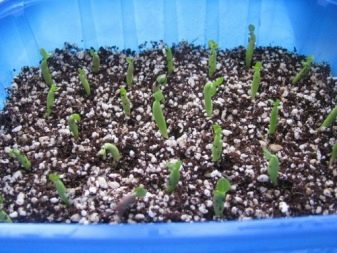
These tropical succulents are very light-demanding. For normal development, adeniums need daylight hours, the duration of which is at least 12 hours. The use of special lamps allows you to compensate for the lack of natural light.
To grow healthy and regularly flowering succulents, it is important to maintain a stable indoor temperature. The most comfortable for them is the temperature range within 30-33 °
A short drop in temperature within 5 ° is not dangerous for these plants, however, strong drops should be avoided. It is also not recommended to increase the room temperature over 38 °. Such conditions cause severe discomfort to adeniums and can provoke their wilting.
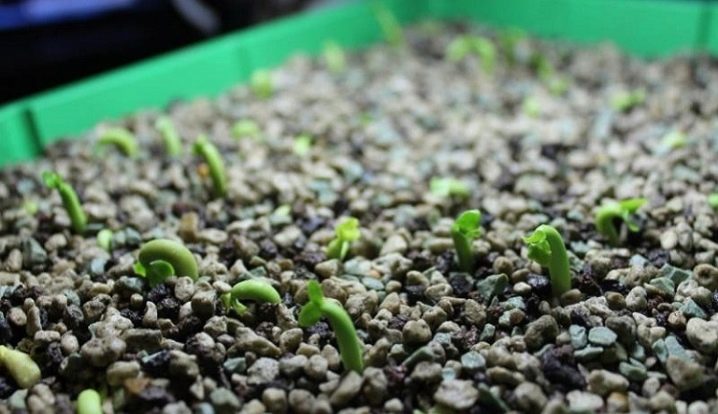
Varieties of adenium
Adenium Fat or Obessum (A. Obessum) - at home, a perennial tree, up to 150 cm high. The leaves of the culture are green, rounded with a pointed tip. The trunk is single, covered with dark gray bark. There are whimsical varieties. They need special care. This is, first of all, bright lighting. It so happens that it is because of the lack of light that obese adenium does not bloom. The flowers are white, red. There are varieties with a border on the corolla petals, spots or stripes. Buds, up to 5-6 cm in diameter, are collected in loose racemose inflorescences.
Adenium multiflora is a bush or compact tree of high decorativeness. In a pot it can grow up to 2 meters. Gradually the woody trunk branches out at the apex. In this part there are green leaves. During flowering, the species looks like adenium obessum, but unlike it, there are a lot of flowers.
Adenium Boehmianum (adenium boehmianum) - in structure does not differ from the species described above. The flowers are large, purple in color with a light neck.
Graft
The florist has two methods of vaccination at his disposal:
- Flat.
- V-shaped.
It is possible that the first variant of grafting is more rational and less traumatic for the plant.
Insofar as:
- no need to split the rootstock on the parent bush;
- the grafted stalk itself has not two, but one cut (flat);
- the cut of the cutting fits snugly against the stock.
In addition, the place of flat-grafting looks more aesthetically pleasing, with its help, cuttings from different bushes can be grafted onto one "stump".
For the classic V-shaped grafting, the apex is removed from the rootstock branch. The remaining stump is split, and a previously prepared stalk is inserted into the resulting gap, the lower edge of which is symmetrically cut off from two sides.
The vaccination site is strengthened with adhesive plaster, cloth, plastic tape. The auxiliary material is removed after successful accretion of the grafting material.
Prerequisites for successful vaccination in any way:
- rootstock and scion must be healthy;
- there must be at least one live kidney on the scion;
- the bush to be grafted and the plant that produced the cutting must be in the growing stage;
- trimming the edges must be carried out with a disinfected tool;
- the grafted plant must be kept in a comfortable environment;
- the connection point must remain stationary.
For a flat scion:
- The rootstock branch should be of a larger diameter than the scion (or the same).
- The ends of the plant to be joined should have a straight cut.
- After joining, the formed branch is carefully wrapped with polyethylene, and then the vaccination is securely fixed using adhesive plaster and electrical tape.
Adenium, like any plant, can face various problems, diseases and pests. To avoid this, read our articles on pruning and caudex shaping rules.
When do they begin to bloom after vaccination?
The flowering of varietal adeniums and grafts occurs in a few months.
Adenium is a very “grateful” plant. For simple care and warmth, both spiritual and quite real, he will certainly thank you with exuberant flowering. And for experienced experimental florists, it will allow you to get buds of different colors on one branched bush.
Cuttings
Advantages:
- A stalk that has taken root can please with flowering in the coming year (how to make adenium bloom at home?).
- The plant will become a clone of the parent and retain the color and shape of the flowers.
Disadvantages:
- Cuttings do not always take root.
- In specimens grown from a cutting, it is sometimes difficult to form a voluminous caudex of increased decorativeness (what are the conditions and methods of caudex formation?).
Material for grafting adenium by cuttings is obtained after pruning the parent bush (how to prune adenium at home?). It is more rational to take material from a plant at the beginning of summer, after setting stable warm weather - sufficient lighting and a warm atmosphere increase the percentage of plants that take root.
Cuttings of Adenium can be of any length, but 12 - 15 cm "sticks" with several leaves are the easiest to take root.
Not all solutions for early root formation can be used for adeniums. Therefore, it is better to let the cutting air dry for about 30 minutes, and then gently stick it into the ground 5 centimeters deep, and then cover the container with a transparent polyethylene cover, a half-liter plastic glass, and a glass jar.
Important conditions for caring for a rooted cuttings:
- The soil (2 tsp perlite with 1 tsp vermiculite or 2 tsp clean sand, 2 tsp sphagnum, 1 tsp perlite) should be stable slightly moist, but not wet;
- The plant should be provided with warmth (25–35 ° C) and light;
- It is impossible to use any solutions with stimulants when watering.
Propagation by cuttings in water
Cultivation of the root system in adenium cuttings is pure lottery.
There is a 50–70% chance that a cut off branch may start to rot.
But in some flower growers, cuttings still give roots with this method of germination.
Rooting
How to root Adenium? For rooting, cuttings need from a crescent to three. Twigs, separated from the bush and planted in the ground in warm weather, acquire a root system faster.
If the procedure is carried out in early spring or late autumn, outside a special greenhouse, then a mat with a heating function should be spread under the flowerpot with cuttings. Or place the container directly on the heating system line near the window.
Care rules
Before making adenium bloom at home, comfortable conditions are created for him. A lot of time and effort is not required to take care of a desert guest. There are no such plants that require a lot of attention in deserts. Therefore, we make this plant bloom without making huge efforts to this.
Lighting

Since the perennial is light-loving, therefore it should be placed in the brightest place. The most suitable for this is a window sill, with a window facing south or southwest. Unless young seedlings from seeds cannot be placed on such a window.
During the rest period
The dormant period begins at the end of autumn. Adeniums must be "sent to rest".Otherwise, they will not bloom, and if they bloom, then there will be few flowers, and the flowers themselves will appear small and pale.
To do this, place a container with a flower in a slightly shaded place. You also need to reduce watering to one per month. The temperature in the room should be no more than 15 ° C. Do not be alarmed if the plant sheds its leaves.
Regular pruning and pinching
At the beginning of the first spring month, when the perennial begins to "come to life" after hibernation, cut off its shoots. This allows the crown to form and encourages the bud setting.
You can also trim the roots. Particularly interesting shapes are obtained when the plant is planted on a round plate. In this case, the root grows to the sides like an octopus. Roots can be strengthened with sticks or toothpicks, giving the roots an exotic look. In any case, the pruning and crown shaping operation must be performed before the plant begins to bloom.
It should be remembered that adeniums should not be cut low. Pruning too low results in irregular, thin stems and prevents the formation of the correct crown shape.
Pinching refers to cutting off the tops of the central conductors and lateral shoots. Cut off twigs 1-2 cm. This is the same pruning process, only small tops are cut off. Pinches and trims help stimulate branching and crown formation.
Watering
In winter, the plant is watered once a month. And with the beginning of its active growth, water is gradually watered more and more. Water for this purpose should be used soft, slightly sour and warm. Watering should be done only when the soil is dry. Periodically, adeniums are sprayed from a spray bottle.
Soil selection

For this "exotic" soil must be selected very carefully. Lightweight and moisture permeable is ideal. Fertilizers are added to the mixture. The reaction of the potting mix should be neutral or acidic.
You can use store-bought soil for growing orchids. They add to it perlite or vermiculite, only their percentage should not be more than 20%. The soil should also contain coconut fiber (peat is possible), humus with coarse sand. The ratios of the components are taken as follows: 5: 2: 1: 2.
The plant loves loose soils, therefore, in the composition of the soil, the addition of a large number of rippers is even more useful for it. Their role can be played by:
- crumbled brick;
- sand with perlite;
- charcoal chips, etc.
Transfer
Adenium will bloom better and form buds earlier if transplanted more often. But when transplanting, you should not take too large a pot. Experts recommend doing this in the evening or on a rainy day. And after the transplant, you need to stop watering for several days. This desert guest responds well to transfers.
The transplant is performed as follows:
- the plant is carefully removed from the pot;
- look through the roots and stem to remove damaged ones;
- a drainage layer and a little soil mixture are poured at the bottom of the new flowerpot;
- place a seedling and sprinkle with the same soil, carefully sprinkling the voids between the roots.
Young seedlings need to be replanted every year. Adult plants are best replanted every two to four years.
Features of growing seeds
It will not be difficult to acquire planting material. It can be found in stores or purchased online.
It is worth noting that the seeds should be in the form of light brown tubes.
The highest percentage of their germination remains in the first six months after harvest. Then the probability of successful sprouting is significantly reduced.

When breeding adeniums by seed, plants may lose their varietal characteristics. As a result, flowers of very different shades can grow.
When growing, some features should be taken into account:
- Sow seeds from April to June;
- Soak the seeds for a while in warm water before planting;
- Prepare the sowing mixture according to the recipe described above;
- There can be any container for seedlings, but at the bottom it is imperative to make drainage holes;
- When planting, the seeds are not buried in the soil, but are laid out on the surface of the soil and pressed a little;
- Then spray the soil with water from a spray bottle and cover with foil;
- Ventilate daily;
- During planting and cultivation, a temperature of 30-35 ° C should be maintained. At lower temperatures, the probability of seed germination is significantly reduced;
- When the seedlings already have 2 leaves, they can be planted in separate hills;
- Adenium grown from seed begins to bloom in 2 years.
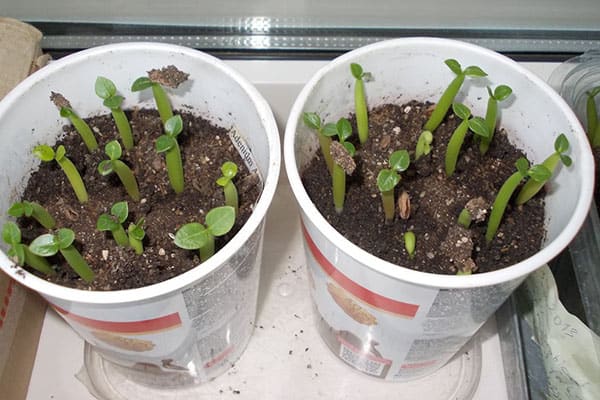
Thanks to this method, many adeniums can be grown at once. It will be much cheaper than buying a flower from a store.
Germination errors
Some growers, even after several attempts, still fail to obtain young succulent seedlings from seeds.
There are several major mistakes made at different stages of growing that prevent a healthy young plant from being produced. The most common:
- Prolonged soaking of seeds. If the seeds are kept in water for more than 3 hours, they will "suffocate" and die.
- Planting seeds in peat tablets. Peat is highly acidic, which kills the seeds even before they germinate. An excessively humid environment is created in the peat soil, the seeds in it simply rot.
- Failure to comply with the temperature regime. For the first 2 weeks, it is necessary to provide the seeds with a constant temperature of + 28-32 ° C. Fluctuations in numbers, their sharp decrease or increase - all this affects their germination and survival.
- Early transplant. Sometimes flower growers are in a hurry to plant newly emerged seedlings so that they are "more spacious". For the first 1.5-2 months, the plants are unable to survive the change in location, soil and microclimate. Until 4-5 leaves appear, they should not be touched at all.
How to form caudex
Caudex is a very interesting "detail" of adenium, which gives the plant an unusual look. It is formed with age by itself in the form of a bottle, but if desired, you can get other forms. For work you will need:
- grown seedling with 3-4 leaves;
- container for planting;
- a small circle of plastic;
- garden pitch;
- sharp knife.
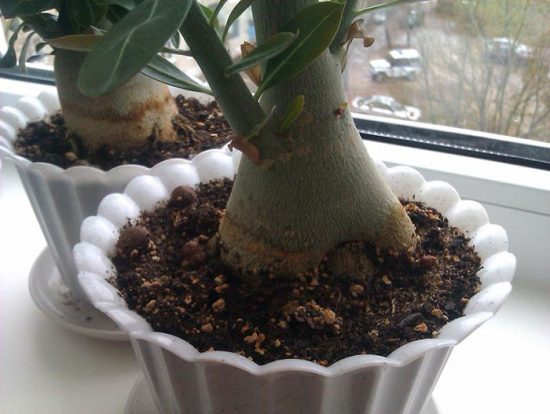 The trunk of adenium can be shaped
The trunk of adenium can be shaped
Caudex is formed as follows:
- The seedling is carefully removed from the soil.
- With a disinfected knife, the taproot and the top of the plant are cut, followed by their processing with garden pitch.
- The plant is placed on a plastic circle. The roots are spread over it in the desired direction.
- Sprinkle with a small layer of earth and tamp lightly.
- Water the plant only a day after the procedure.
The formation process is quite lengthy. It can take several months or even years. But the result is worth it. Experts are able to create real masterpieces in the form of figures of animals, birds, etc.
Adenium is no longer a rarity. It can be purchased from a store or ordered online. However, for true lovers to grow a wonderful tree from seeds on their own is a matter of principle. And to do it is quite simple, there would be a desire.
Home care for adenium

Illumination
When growing adenium at home, it needs bright sunlight, and it does not need to be shaded. In this regard, it is recommended to place it on a south-facing window. After the end of winter, when there was enough light, the bush will need to be accustomed to the direct rays of the sun gradually, otherwise burns may form on its stem. Another flower must be shaded in the event that direct sunlight falls on it for more than 5 hours a day.
Temperature regime
When growing such a crop at home, in the summer it needs to provide an indoor air temperature of 25-30 degrees.Experts recommend moving adenium outside in the summer, where it needs to be placed in a place that has reliable protection from rain.
In order for the flower to begin a dormant period, it is necessary to reduce the air temperature, as well as reduce the duration of illumination. During this period, the foliage turns yellow and flies around. In winter, in the room where the flower is located, the air temperature should not be lower than 10 degrees, while it feels best at this time at a temperature of 12-15 degrees. Make sure that the roots are not overcooled, otherwise the bush may die.
How to water

When caring for a flower grown indoors, he should ensure timely watering. This procedure is carried out immediately after the substrate in the container is completely dry. In winter, watering should be very sparse and sparse. If in winter adenium is kept at an air temperature of 15–20 degrees, then it is watered only after the substrate has completely dried out. If the bush hibernates in a cooler place, watering is carried out extremely rarely or it is completely stopped.
Young bushes should be watered very carefully as well. When in the spring the bush starts growing for the first time, it will need to be watered 15-20 days after the buds appear and the bush begins to grow
Spraying
During the period of intensive growth, the bushes need to be moistened with a fine sprayer
After the flowering will begin, the bushes need to be moistened very carefully, since the liquid should not be on the surface of the flowers
Top dressing of adenium
Top dressing of adenium is carried out in the spring, summer and at the beginning of the autumn period, they do this no more than 1 time in 4 weeks. To do this, use fertilizer for indoor plants, while the concentration of the solution should be from 1.5 to 2 percent.
How to fertilize Adeniums
Pruning

Pruning of bushes is carried out only if necessary, and this is done only in spring. To form a bush in the form of a tree, you need to shorten the side branches by 1/3 of the length. To form a bush, you need to cut it below. The formation of adenium takes quite a long time, and it is quite difficult, but if everything is done correctly and in a timely manner, the result will be impressive.
Transfer

The transplant of young plants is carried out annually in spring, and adult specimens are subjected to this procedure only if necessary. Experts recommend choosing a light-colored pot for planting, this will help protect the root system from overheating. For planting adult plants, choose wide and small containers. After transplanting, the bush should be watered only after 4–6 days, during which time the roots will have time to dry out.
The substrate should be loose, and it should consist of turf and leafy soil, as well as coarse sand (1: 1: 1), and a small amount of charcoal should also be added to it. The soil mixture for transplanting an adult plant should include a large amount of sod land, and broken bricks are also added to it. Don't forget to make a good drainage layer at the bottom of the pot.
Virulence
Such a plant contains poisonous juice, in this regard, after work with it is over, hands must be thoroughly washed with soap. The flower should stand in a place that is inaccessible to animals and children. If you decide to decorate your home with adenium, then this must be taken with full responsibility in order to avoid poisoning.
Table: the manifestation of care errors and how to fix them
| External signs | Probable cause | How to fix the situation |
| The leaf blades turn yellow and fall off. | The natural reaction of the plant, adenium prepares itself for a dormant period. | Provide the flower with suitable conditions, rearrange to a cooler place. |
| Caudex became soft and spots appeared covered with a yellowish fluff. | Caudex is rotting. | Reduce watering and provide the plant with bottom heating, for example, put adenium on a radiator. |
| The leaf blades are deformed, twisted, spots appear on them. | The concentration of fertilizers is exceeded. | Stop feeding completely or transplant adenium into fresh substrate. |
| The tips of the leaves dry out. | Lack of potassium. | Feed the plant with potash. |
Features of adenium
The name of the plant is translated from many languages as "desert rose". The natural habitat of the adeniums is rocky deserts. Only 7 species are known in nature, and most can be bred at home.
Among the potted species, the most common is Adenium obesum. Of all the species, it is the most unpretentious and blooms before anyone else.
The most valuable are the specimens with thickened stem bases. This part of the plant is called caudex or bottle. There, the flower stores nutrients and water necessary to ensure normal life.
With the cultivation of a plant, you need to be extremely careful. Adenium is classified as a poisonous plant. This is also the reason for its unpopularity among gardeners.
This plant should be kept away from children and pets. Under no circumstances should they be placed in children's rooms and on low window sills, and after contact, wash your hands well, as well as the tools that you used to work with adenium.
For this reason, many lovers of this plant propagate adenium by seeds.
2. Reproduction, growing from seeds
It is possible to grow from seeds, but it is a rather lengthy process.
In addition, you need to pay attention to the maturity of the seeds - the pods must dry naturally
The seeds must also be fresh, germination begins after 3 - 5 days at a temperature of at least 26 ° C, germination is good.
- The seedbed should be 50 to 70 percent drainage material, such as perlite, vermiculite or coarse river sand.
-
At the bottom of the cups, be sure to lay out a drainage layer of fine expanded clay.
- Before sowing, the seeds are soaked in warm water with growth stimulants for several hours, but you can do without soaking.
- The seeds are placed on the surface of the soil, only slightly pressing into it with your fingertips.
- Since the seeds need a high temperature for germination, the container with the seedlings can be placed, for example, on a heating radiator, and when the first shoots appear, take it out to a brighter place.
- Sometimes the husk from the seed remains on the top of the seedling - it should be carefully removed, holding the plant.
- Young plants are grown only in small containers with large drainage holes under a glass or plastic wrap shelter - thus they are kept in the greenhouse.
- Every day, the crops are ventilated for several minutes and condensation is removed.
- Remember that direct sunlight should not hit the tender young leaves of the seedlings - place the seedlings in a well-lit place without access to the sun.
If the seeds are sown in several pieces in one container, then with the appearance of the first true leaves, they will need to dive into separate cups.
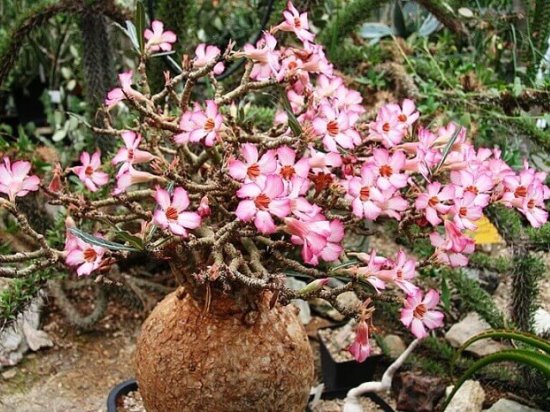
How to root plant cuttings.
Vegetative propagation or grafting is often successful.
- Propagation by cuttings should be accompanied by the use of bottom heating.
- Cuttings 10 - 20 cm long are separated from the mother plant with a sharp sterile instrument.
- The bases of the cuttings are pretreated with rooting powders and placed in a mixture of perlite and vermiculite.
- Most of the leaves from the cuttings should be removed to reduce moisture evaporation. If there are buds on the handle and their flowers are also cut off without regret.
- Rooting can be done in clean and dry perlite.
- The first watering is carried out a week later.
- It is worth remembering that plants obtained from cuttings often do not form caudex.
Succulents also reproduce by grafting - flowers of various shades appear on one plant.

We increase decorativeness
The value of adenium as a pet also lies in the fact that its owner can independently form an individual, different from other plants, appearance of a flower.
Pruning the central shoot
Not everyone is happy to grow a long green "hose" into which adenium will certainly turn without pruning. Its apical kidney is the most powerful. She pulls all the forces of the plant onto herself, and the lateral shoots risk never waking up.
Pruning is done to stimulate their development. The desired result is the uniform formation of several side branches instead of one central one.

Pruning the central shoot contributes to the harmonious development of several lateral branches of adenium at once
Pruning of the main shoot of adenium is done a few weeks after the spring transplant. Before the procedure, the flower should grow a fairly thick caudex (at 12-18 months). Then, predicting the appearance of future new branches, you can adjust the appearance.
Experienced growers warn against pruning the central shoot too low: then the lateral branches will develop weak.
Pruning is done with a sharp knife (blade) in the spring, with the onset of active growth of adenium. The cut site can be sprinkled with ash or crushed activated carbon. After 40-50 days, the plant will give new branches from the axillary buds.
A pruning option is pinching: when about 2 cm still remains from the shoot.
Video: transplant and pruning of adenium
Wake up sleeping kidneys
It is possible to wake up the dormant axillary buds of adenium not only by pruning the central shoot. What if the procedure has already been carried out, and you want to further stimulate branching? Or, along with the central shoot, "wake up" and the side ones? Or does the plant need to be rescued? In this case, a cytokinin paste is used.
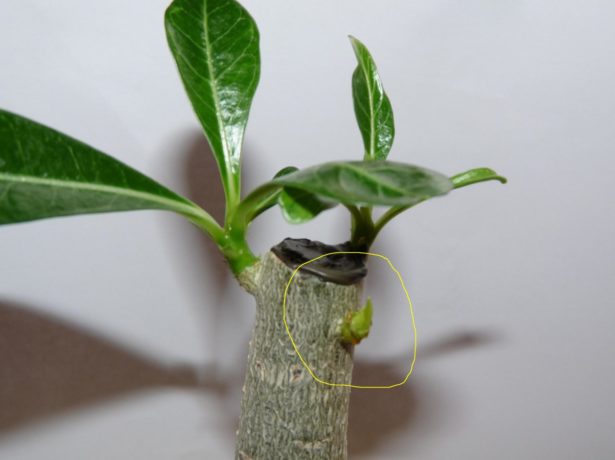
The result of using cytokinin paste for the development of axillary kidneys of adenium
At the end of the match, a small portion of the drug is applied to the kidney, which they want to "wake up". Will she wake up? There is no absolute guarantee. Such stimulation accelerates the development of the kidneys, which were already ready to bloom, but for some reason were delayed in development. Perhaps the cytokinin paste will never have any effect on some of them. However, with the help of treatment with the drug, in some cases it is possible to radically change the appearance of adenium for the better.
Should the taproot be pinched?
The adenium taproot is pinched at an early age, usually during the first transplant. This is done so that during the growth process it does not reach the bottom of the pot. If this happens, the plant can, resting against it, noticeably lean to one side.
Without a taproot, the plant develops an extensive fibrous root system and grows well in low, flat pots.
Pinching is done 0.5-1 cm below the lateral roots. Without a taproot, they begin to develop vigorously and get fat. At the next transplant, they can be beautifully intertwined, and the plant itself can be raised in a pot. Saline stains on the caudex with such a transplant are washed off with plain water using an old toothbrush.
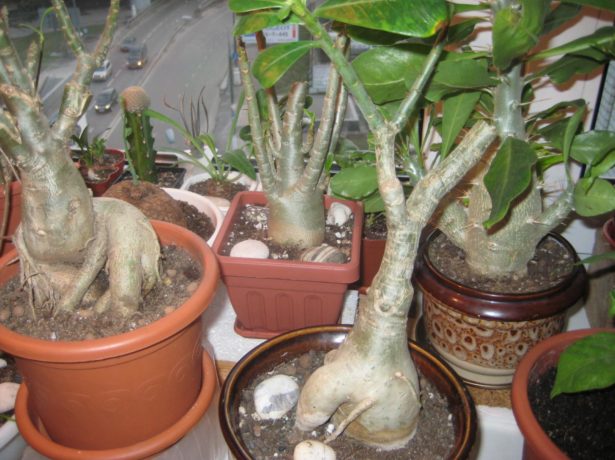
Intertwined and raised lateral roots ensure the uniqueness of the adenium
Bloom
It is great if the grown adenium pleases with flowers without additional efforts on your part. However, sometimes the plant needs a little help.
One of the earliest flowering of adenium on a windowsill in the middle lane was recorded in a 4-month-old plant. But usually in adenium this happens at 2-3 years of age.
Thai growers advise: adenium with caudex with a diameter of 18 cm or more can be made to bloom by arranging a "cold period" for two weeks after spring pruning and fertilization. After that, it is necessary for three days to gradually water the flower with fertilizer for orchids, diluted according to the instructions.And repeat the cold period. Several alternations of such stages for three weeks - and the buds will appear. After that, watering must be made complete.
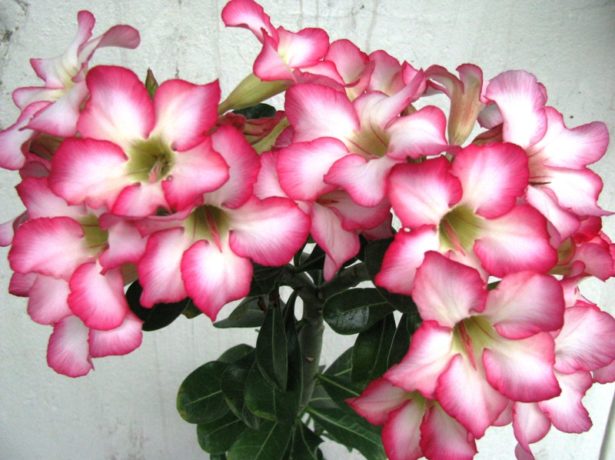
Adenium bloom rewards all efforts to grow it
The main rule of watering and spraying adenium at this time: water should not get on the petals. If this happens regularly, the flowers will rot.
Growing adenium from seeds at home
How to grow adenium? Reproduction of adenium by seeds is the simplest and most effective way. With good quality planting material, it gives quite good results, while being a fascinating process.
As a rule, planting adenium requires minimum conditions. The air temperature should be at least twenty-eight degrees, and the soil should be loose and breathable.
How to plant?
Sowing seeds can be done at any time, but it is better to do this in the spring or summer, when the seedlings can receive enough light and grow stronger by the winter.
-
Seed preparation for planting.
The seeds are placed for half an hour in a warm solution of fungicide or potassium permanganate. They are then transferred to a growth stimulant solution for four hours.
-
Soil preparation.
The most optimal option for sowing seeds would be an ordinary universal soil mixture, combined with the same amount of baking powder (perlite, crushed brick, coarse sand, and others).
-
Selection of capacity.
For sowing, it is better to use low and wide boxes or a mini greenhouse. There should be a good drainage layer at the bottom.
-
Sowing seeds.
Seeds must be placed on the surface of the soil and covered with a thin layer of soil (up to one centimeter). The boxes are covered with plastic wrap and placed in a warm, shaded area. If several types of adenium are sown at the same time, it is necessary to put separators with inscriptions, since at the first stage all seedlings will look the same.
The shelter must be lifted daily, and watering must be done from a spray bottle. After the emergence of seedlings, the film is removed, and the container is rearranged to a more illuminated place.
Germinating seedlings care
Depending on the variety of adenium and the quality of the seeds, seedlings may appear on the fourth day, or maybe in a month. The temperature in a room with young seedlings should be at least twenty degrees. Saplings need to be taught to light gradually. V within a week after several hours of exposure to the sun, you need to create shading for them.
Watering should be moderate, but without drying out the soil. Since the seedlings do not have caudex, they can quickly die from a lack of moisture.
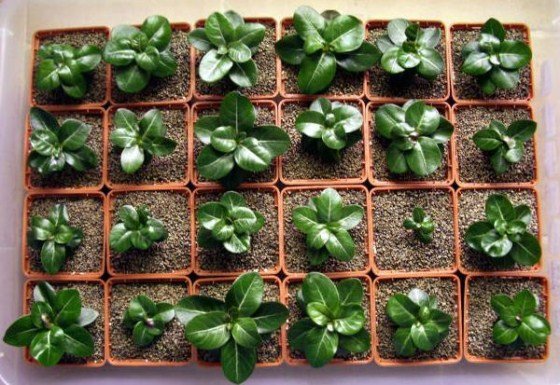
When will it bloom?
Usually, the first flowering of adenium grown from seed occurs two years after planting. But sometimes this can only happen in the third or fourth year of growth. Often the first bloom ends in failure. The plant can give buds, but due to lack of strength it dries up or sheds them.
Failure to comply with the rules of maintenance also affects the time of the beginning of flowering:
- Lack of lighting and heat;
- Incorrectly selected soil;
- Unsuitable planting container.
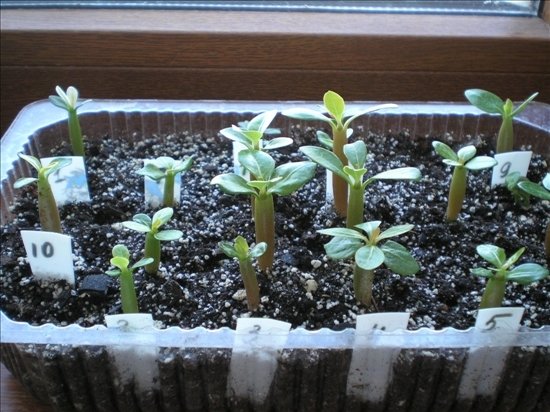
The appearance of adenium also affects the beginning of flowering. As a rule, adenium obesum blooms earlier than others.
After the first buds appear, you do not need to rearrange the plants to another place and feed, you just need to increase watering. The buds ripen within a month.
Adenium seedling care
Caring for adenium seedlings is not difficult. The main thing is to maintain proper lighting, as the plant loves light very much. It is better to put pots with adenium on the south window, but at the same time the direct sun should fall on the plant no more than five hours a day.
Try to shade the plant a little after winter, as direct sunlight can burn the trunk.
In summer, the temperature for adenium should be no more than 30 ° C.Also, it sometimes needs to be exposed outside, under an awning, to protect it from rain.
As with all plants, there must be a dormant period for adenium. This happens during a drop in temperature and lighting. In winter, the temperature should not be lower than 10 ° С, and it is even better to adhere to temperatures up to 15 ° С.
Important! Avoid hypothermia of the roots, this can lead to the death of the plant.
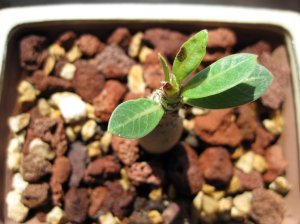
In the summer, there should be regular watering after the soil is completely dry.
In winter, it is better to water adenium little and infrequently. It is best to do this after the soil has dried. If you have chosen a place with a temperature below 15 ° C for adenium, then it is better to water the plant rarely or stop watering altogether.
In early spring, it is better to water the plant 2-3 weeks after budding.
Since the seedlings of adenium will actively develop, you need to carefully spray the plant with a fine spray. After the beginning of flowering, you need to spray the plant carefully so that water does not get on the flowers.
Many novice gardeners are interested in how to feed adenium and whether it is worth doing it at all. Our answer is worth it. For a houseplant, use houseplant fertilizer. You need to feed the plant in spring, summer and early autumn, but not more than once a month.
The concentration of the fertilizer solution should be up to 2%.
Adeniums from seeds: growing
First of all, we select the seeds. There are about 10 types of adeniums, each of them has its own characteristics. The most common and easy to care for is A. Obesum. You can order seeds on AliExpress (which is unreliable), and on numerous sites on the Internet.
Preparing the container
Any container in the shape of a bowl will do, that is, a shallow, wide box.
We make many small holes in the bottom of the container, using a nail or screwdriver.
It is very good if there is a lid.
Seed preparation
Before planting, adenium seeds can be soaked for 3-4 hours (optional).
Here you need to be careful - do not leave the seeds for more than 4 hours.
Otherwise, negative consequences may occur: decay, the percentage of germination falls.
The water should be warm all the time, you can add potassium permanganate to it, growth stimulants (Epin, Ribav), fungicides - prevent decay (Fitosporin).
It is better not to use the drug Maxim. Its effect is bad for germination.
You can plant seeds without preliminary preparation.
The soil
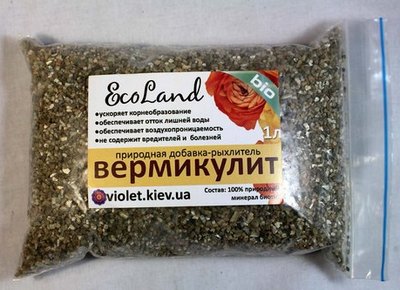 The soil should be loose and breathable.
The soil should be loose and breathable.
Most of it, 50-60%, is universal soil (Terra vita is one of the best brands).
Everything else is baking powder.
It is better to use perlite, as it absorbs excess moisture when flooding, and, on the contrary, when there is a lack of moisture, it gives the accumulated water to the flowers.
Vermiculite in large quantities is dangerous because it helps to retain moisture in the pot for a long time.
You can use a little charcoal, brick chips, foam balls.
Sowing
At the bottom of the planting tank we put drainage (small expanded clay, pieces of brick). Next, fill in the soil. We spread the seeds flat, without sprinkling them, but slightly pressing down with our finger. Now sprinkle the soil a little with water from a spray bottle or pour it from a teaspoon.
Important: the ground should be moist, but not wet.
We place the container in a bag or cover with a lid. Each grade of adenium must be marked. If there are several varieties in one bowl, then we put toothpicks with the names of varieties attached to them near the seeds.

Growing temperature
We place the container with seeds in a warm place. For a central heating battery, for a shoe or towel dryer, there are many options. 28-35 ° C is the temperature required for successful germination.
In the morning and in the evening, we open the greenhouse and ventilate it for 30 minutes. When the top layer of the soil dries up, slightly moisten it with water.
Seedlings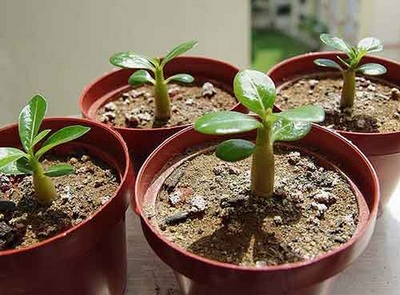
The first "babies" will begin to appear in 3 days.
They look like plump green columns with two small leaves on top of the head.
All adenium seeds can germinate within two weeks of planting.
After the emergence of mass shoots, you need to place the container with them in a bright place.
It is undesirable to remove heating for successful germination, at least for 10 days.


